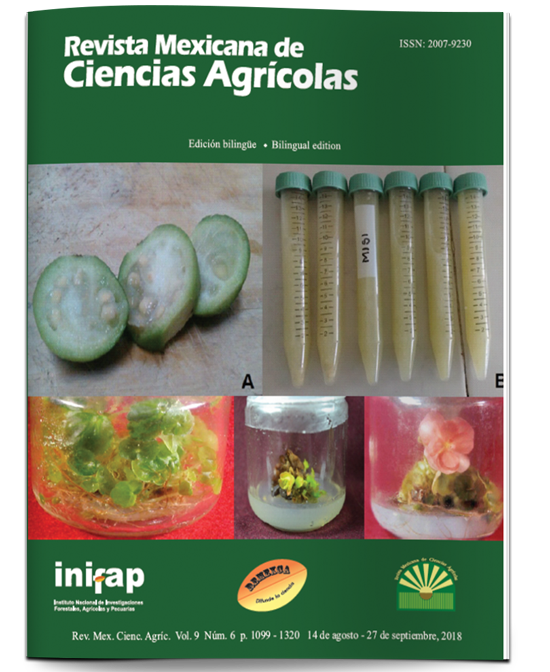Production of corn hybrids with stabilized urea and foliar nutrition
DOI:
https://doi.org/10.29312/remexca.v9i6.407Keywords:
Zea mays L., microelements, nitrification inhibitors, plant nutritionAbstract
Six corn hybrids were evaluated in Ixtlahuaca, Villa Victoria and Temascalcingo, State of Mexico, in factorial arrangement, with conventional urea, Urea NitroXtend with Agrotain and Urea NitroXtend with Agrotain + S at a rate of 250 kg ha-1 of N and four foliar fertilization treatments (Control, Quimcasa, Disagro and Bios). The combination of factors 3*6*3*4 with four repetitions. The foliar treatments were applied in stage V4-6 and V9-10. A sub-subdivided plot design was used, with the larger plot for hybrids, medium plot for urea types and smaller plot for foliar fertilization treatments. The Tukey test at 5% was used for the comparison of means. For grain yield, the averages were Ixtlahuaca 13.6, Temascalcingo with 11.7 and Villa Victoria 10.8 t ha-1, for hybrids it was for the BG1304 of 14.24, BG1384 with 13.79, Syn1806 with 12.28, Albatros with 11.60, H-51AE with 10.25 and H-57AE with 10.24 t ha-1, no response was found to the types of urea, while for foliar fertilization the control (11.13 t ha-1) was surpassed by the Quimcasa treatments (12.36 t ha-1), Disagro (12.49 t ha-1) and Bios (12.30 t ha-1). Positive interactions of hybrids (H) by types of ureas (U) and hybrids x foliar fertilization (F) were found. The high yields obtained are due to the use of new hybrids and the adoption of the best agricultural practices (MPAs), among which soil fertilization and foliar nutrition stand out.
Downloads
Downloads
Published
How to Cite
Issue
Section
License
The authors who publish in Revista Mexicana de Ciencias Agrícolas accept the following conditions:
In accordance with copyright laws, Revista Mexicana de Ciencias Agrícolas recognizes and respects the authors’ moral right and ownership of property rights which will be transferred to the journal for dissemination in open access. Invariably, all the authors have to sign a letter of transfer of property rights and of originality of the article to Instituto Nacional de Investigaciones Forestales, Agrícolas y Pecuarias (INIFAP) [National Institute of Forestry, Agricultural and Livestock Research]. The author(s) must pay a fee for the reception of articles before proceeding to editorial review.
All the texts published by Revista Mexicana de Ciencias Agrícolas —with no exception— are distributed under a Creative Commons License Attribution-NonCommercial 4.0 International (CC BY-NC 4.0), which allows third parties to use the publication as long as the work’s authorship and its first publication in this journal are mentioned.
The author(s) can enter into independent and additional contractual agreements for the nonexclusive distribution of the version of the article published in Revista Mexicana de Ciencias Agrícolas (for example include it into an institutional repository or publish it in a book) as long as it is clearly and explicitly indicated that the work was published for the first time in Revista Mexicana de Ciencias Agrícolas.
For all the above, the authors shall send the Letter-transfer of Property Rights for the first publication duly filled in and signed by the author(s). This form must be sent as a PDF file to: revista_atm@yahoo.com.mx; cienciasagricola@inifap.gob.mx; remexca2017@gmail.
This work is licensed under a Creative Commons Attribution-Noncommercial 4.0 International license.



